Nirvana: the release from the karmic rebirth cycle that binds humanity to suffering…er…excuse me…this is an article about the famous grunge rock band of the ’90s. Nirvana is a household name even today due to their meteoric rise to stardom and the accompanying flurry of MTV coverage and mass radio appeal they garnered. They have sold over 25 million albums in the US alone, with an additional 75 million albums sold worldwide and have been considered a defining band of Generation X. In 2014, they were inducted into the Rock and Roll Hall of Fame in their first year of eligibility. Their music still enjoys plenty of airplay and circulation and is a testament to the band’s influence and raw power.
Beginnings
At its onset, the band didn’t go by the name Nirvana – nor were they made up of the same classic lineup. In 1985, shortly after Kurt Cobain dropped out of Aberdeen High School, he started a “joke band” called Fecal Matter that was comprised of a circle of friends that included members of the band Melvins. The project never went anywhere, but Cobain continued to circulate copies of the demo to friends and peers to attract attention around his music. He had hoped to eventually play with bassist Krist Novoselic, who later heard Cobain’s tape that was going around and requested to start a band. They had cycled through various names (Skid Row, Ted Ed Fred) but fortunately, eventually became Nirvana.
Bleach/Nevermind
Nirvana’s lineup had several drummers come and go at the onset, with Chad Channing eventually playing on their debut record Bleach (though a few tracks featured Melvins drummer Dale Crover, as he had played with Cobain on Fecal Matter songs that were re-recorded for Bleach). There was a fatal flaw though: the Sub Pop record label strongly preferred their acts to play grunge music, and Cobain felt creatively at the whim of the label to adhere to that aesthetic with his material for the band. The music on Bleach therefore was stripped of its more artful aspects to appease the fanbase and label. In 1993, Cobain also famously told Spin magazine that on the record he “didn’t give a flying f*** what the lyrics were about,” and wrote the large majority of them not long before recording, sometimes immediately beforehand.
In 1990 Channing and Nirvana split ways, leaving the band without a regular drummer. They eventually found Dave Grohl who was in need of a band after his hardcore punk act Scream disbanded. With Grohl’s powerful drumming and stage presence added to the mix, the band felt their sound was growing closer to where they wanted it to be. The package was completed when Nirvana recruited producer Butch Vig to beef up the sound of their next record. They were fans of his previous work he had completed with the band Killdozer and thought he would be an invaluable addition to the recording process.
They jumped ship to DGC Records next, but still wanted to work with Vig because they felt comfortable with him and wouldn’t have to shell out percentage points for the album. Once arranged, Nirvana set out to record their classic album Nevermind, but inevitably were unhappy with how the mixes were turning out once they were finished. Vig agreed, and they decided to go with someone else to mix the album. Cobain feared that the wrong choice of engineer would end up making their album sound just like the bands the engineers were known for, and therefore they went with Andy Wallace, who had done Slayer’s albums in the past. Again, they were fans of his production sound and ability to make mixes that were heavy and powerful.
While they were happy with the mixes Wallace did for the album, once it was released, the band had become frustrated with its overly polished sound and felt it took away from the punk rock aesthetic they had hoped to retain. Despite this, Nevermind became a massive hit, and proved that underground music genres like grunge could still find a place in the mainstream. This had shifted the major label’s attitudes on music of this caliber, and opened the doors for a multitude of other bands to see the national spotlight that before would never have been considered due to poor “commercial viability.” Some saw this as a gift and a curse: it brought attention to grunge and the underground, but seemed to clash with the ethos of the music. Nirvana had struggled with a way to allow their next album to achieve new artistic ground and appease the current fans, but to respect their roots more than Nevermind did. And so the next album was born.
In Utero
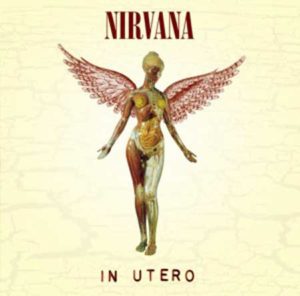
1993’s In Utero
In Utero was to be Nirvana’s third and final album, released in 1993. As mentioned, the band’s ethos changed once Nevermind was released, and they hoped to find a sound that was less sterile on record this go-around. After much deliberation, the band settled on engineer Steve Albini to complete the task. They recorded at Pachyderm Studio in Cannon Falls, Minnesota amid snowy winter conditions. According to Cobain, he had foreseen conflicts with Albini, whose somewhat brash and insensitive reputation had preceded him, but called the sessions the “easiest recording we’ve ever done, hands down.”
In the studio, Albini preferred to let the musicians and rooms do most of the work for him, and recorded live tracks of the songs without vocals or solos to get a more visceral feel. Cobain reportedly completed every vocal track on the record in about six hours, mostly due to Albini’s refusal to double-track him, instead opting for his vocals to be performed in a resonant room to enhance its effect without added overdubs. But what is most impressive was the fact that the album was completed incredibly quickly and mixed over just five days, likely because of a two-week maximum deadline they had imposed on themselves for the recording.
Lyrically, the album was more cohesive than previous offerings, with some songs “almost built on themes.” A general thread found throughout the album was one of disillusionment with newfound fame and how Cobain coped with the growing seriousness surrounding their lives and music. On top of that, Cobain’s drug addiction had started to become much more severe. He initially began using heroin to cope with various chronic issues he was facing, namely bipolar disorder and an undiagnosed stomach condition that caused him constant pain, but the stresses of touring and managing his personal life while becoming a music star had increased his usage to a full-blown addiction. Around this time period, Cobain began a downward spiral of usage and depression stemming from these issues he was dealing with. Despite this though, he remained loyal to the band and his craft and still worked incredibly hard to make the sessions for the album work.
The Gear
One thing about Cobain is certain: he was a wonderful songwriter and had a propensity for very singable and catchy melodies. He also possessed a great sense of what guitar tones were necessary to accompany his brand of music. So if you’re after that unmistakable grinding guitar tone heard on classic Nirvana tunes, it’s pretty well within reach for most anyone to get. Half of the reason for this is that Cobain simply preferred lower-end guitars and equipment and for valid reasons. Case in point: Cobain was a left-handed player and found it difficult to find reasonably priced, but high-quality lefty guitars and so his affinity for searching for junk guitars at pawn shops took hold and never left, even after he could afford to play the absolute best instruments around. Another factor was Cobain’s proclivity for destroying his gear on stage in the heat of the moment, and cheaper gear was easier to replace for the label in a pinch.
“Junk is always best, I use whatever I can find at junk shops.”
Kurt Cobain – referencing his love of cheap gear, Guitar World February 1992
Right before Nevermind came about, the band received a $287,000 advance from Geffen Records, yet Cobain made only meager adjustments to his setup. He became a fan of Fender guitars at this time for their skinnier profile necks, specifically Japanese-made Stratocasters due to their wide availability in left-handed models. He enjoyed the fact that they were generally cheaper and the frets were smaller than on the American versions. He would have humbuckers put into the bridge position as a general preference. Cobain eventually came across a Fender ’65 Jaguar that contained a DiMarzio Super Distortion humbucker (later a Seymour Duncan JB after it was damaged onstage in ’93) and a DiMarzio PAF in the neck position that he regularly played.

Fender Mustang guitar
He has stated on record though, that the Fender Mustang is his favorite guitar because of all of its inherent flaws. In Cobain’s opinion, they were cheap, small, inefficient, and sounded like crap and wouldn’t ever stay in tune properly. But he took a liking to them anyhow and modified them with Gotoh Tune-O-Matic bridges to alleviate the action and tuning difficulties. They would go on to be his primary guitar, though he had also used a variety of others including his Fender Jaguar and his hybrid idea, the Jag-Stang.
While Cobain was in the studio, there were a variety of amps and guitars that ended up on record, several of which were suggested by the producers working on the albums with him. As an example, for the classic track “Lithium,” producer Butch Vig explained that they used an Electro-Harmonix Big Muff pedal through a Fender Bassman to get the darker tone heard on that song. Throughout Nevermind, a Vox AC30 amplifier was often turned to for tonal variation. Despite this, Cobain’s main setup at that time was actually a Mesa/Boogie Studio .22 preamp, a Crown Power Base 2 800W power amp (later a Crest 4801), and varying amounts of Marshall 4×12 cabinets, which ended up on the subsequent tour for the album. For the recording of In Utero though, he had favored a ‘60s Fender Twin Reverb amp.
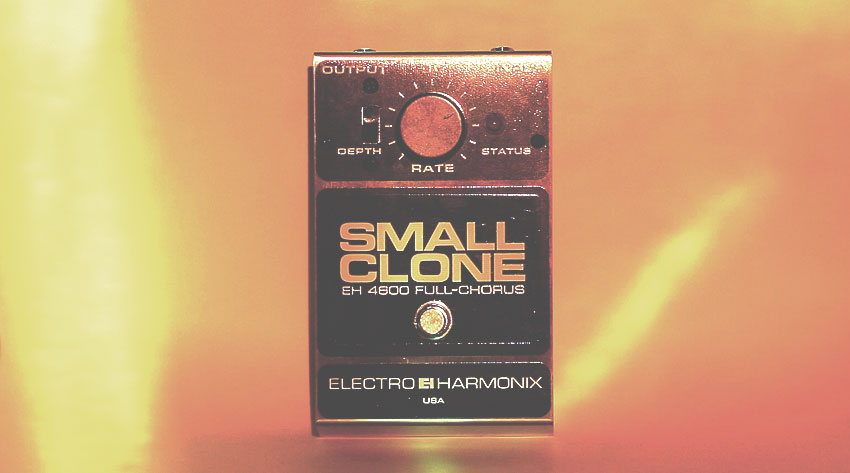 While the amps were a crucial part of Cobain’s distortion tone, he still preferred and pushed for the usage of his stompbox pedals to get his tone the way he liked it. He personally had felt that his Boss DS-1 pedal was a mainstay of his sound, and when playing through different amp rigs he often would pair it with the DS-1 to color his tone to his taste. Later on, it is said he had switched to a Boss DS-2 Turbo Distortion unit, likely because of added features. Besides that pedal, a very Nirvana-associated tone was found in the Electro-Harmonix Small Clone Chorus pedal, which can be heard on classic tracks like “Smells Like Teen Spirit” and the intro to “Come As You Are.” Besides those few pedals, that was the extent of the effects he had usually toured with for the band’s history.
While the amps were a crucial part of Cobain’s distortion tone, he still preferred and pushed for the usage of his stompbox pedals to get his tone the way he liked it. He personally had felt that his Boss DS-1 pedal was a mainstay of his sound, and when playing through different amp rigs he often would pair it with the DS-1 to color his tone to his taste. Later on, it is said he had switched to a Boss DS-2 Turbo Distortion unit, likely because of added features. Besides that pedal, a very Nirvana-associated tone was found in the Electro-Harmonix Small Clone Chorus pedal, which can be heard on classic tracks like “Smells Like Teen Spirit” and the intro to “Come As You Are.” Besides those few pedals, that was the extent of the effects he had usually toured with for the band’s history.
Though we didn’t record any of Nirvana’s music that featured acoustic playing, it’s worth pointing out that Cobain famously used a Martin D-18E guitar that was purchased in late 1993. It is one of the first Martin acoustics to feature electronics, and it was played on the popular MTV Unplugged performance. The stock DeArmond pickup was swapped out for a Bartolini 3AV pickup. Even with all of the aforementioned gear, the magic happened when it was all put together to create Nirvana’s smart but gritty sound.
Our Video
For our video, we wanted to pay homage to the classic Nirvana that was relevant but that used several of the tones that later would became the famed sounds of the grunge movement. We ended up choosing “Lithium,” “Heart Shaped Box,” and “In Bloom,” the latter of which contains my favorite Kurt Cobain solo. We also recorded a few other tracks, namely “On a Plain,” and “Serve the Servants,” but ended up scaling back our video to better showcase the final three songs more succinctly. Between the three songs we chose, we were able to cover a lot of ground.
The intro/verses to “Lithium” have a very dry clean tone to it that we replicated through a Fender ’68 Custom Vibrolux Reverb amp, but the real highlight of the song is the massive chorus section full of that Big Muff/Fender Bassman tone detailed earlier. We actually were able to more faithfully reproduce that tone with a Way Huge Swollen Pickle pedal when we recorded our replication of it because of how it interacted with our setup – it was initially big with the Big Muff (pun intended), but came across a little bit off-sounding for copying the recording’s sound faithfully. For the remainder of the drive tones heard on the other songs, we used a Boss DS-1 40th Anniversary Limited Edition pedal with settings tweaked as needed.
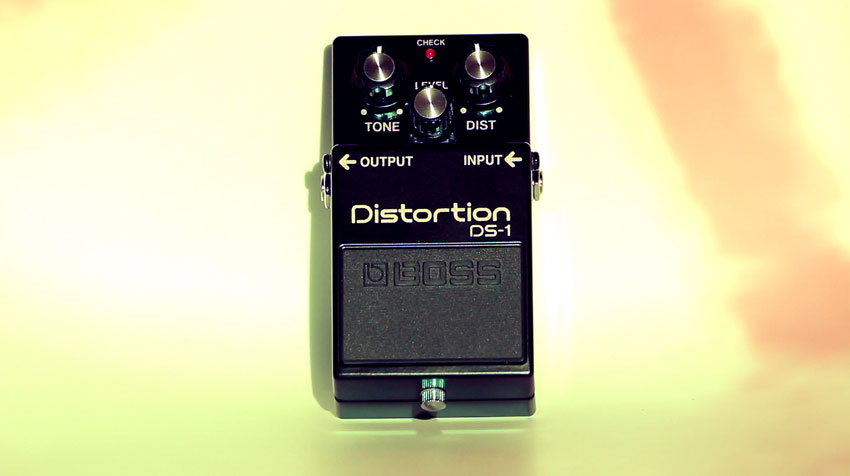
40th Anniversary DS-1 pedal
On a slower note, we chose Heart Shaped Box for its dark mood and great “watery” chorus effect on the intro. The chorus section is actually full of bends I never even fully realized were there until we recorded the song without vocals – a little something extra buried in there very slyly. This was a good example of why his melodies and vocals were usually a very crucial aspect of the songwriting. To top it off, there’s a nice short solo in there (check out the bass playing underneath it too) that helps give the song some extra variety.
We found “In Bloom” to be the most fun to record, and also the most challenging to get to sound true to the original. The verse of the song gives you an opportunity to hear Noveselic’s solid basslines in action as well. The solo, which is quite spastic, actually contains some really tasteful phrasing buried amongst the noise and dissonant usage of tritones. Overall it is very easily the top Nirvana guitar solo on record, in my opinion.
Gone But Not Forgotten
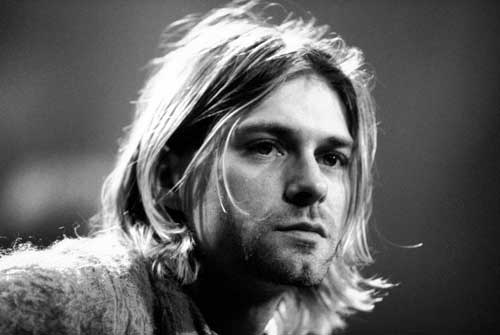
Sadly, despite the band’s rise to fame and accompanying success, Cobain was found dead on April 8th, 1994 from a gunshot wound to the head in his Seattle home. The occurrence and following coverage absolutely stunned the world, as no one expected the leader of a rising band at the zenith of its career to so tragically leave. A figure important to the culture of the ’90s was lost, but his music and legacy carries on through their short but succinct catalog. Nirvana had a sound all their own, and we hope our video is a testament to this fact.

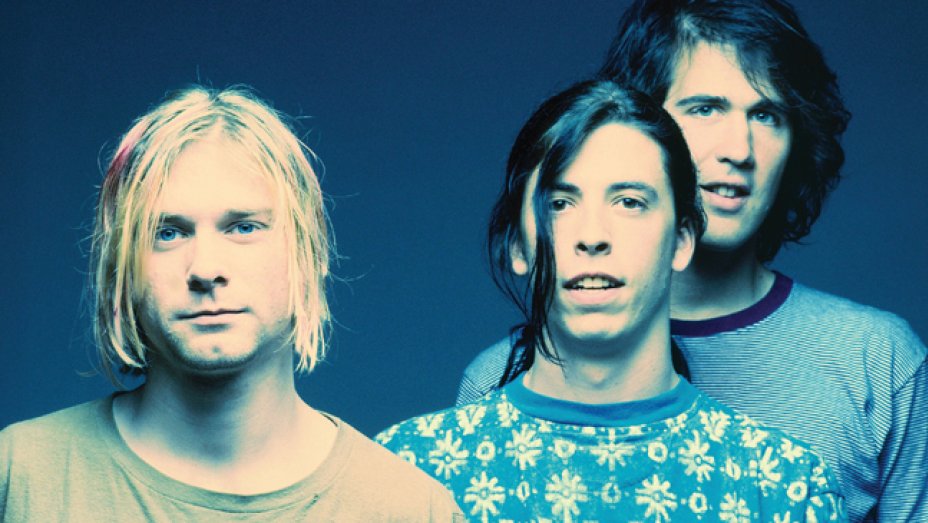
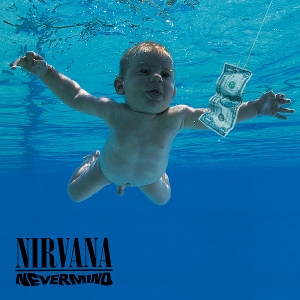


Leave a Reply